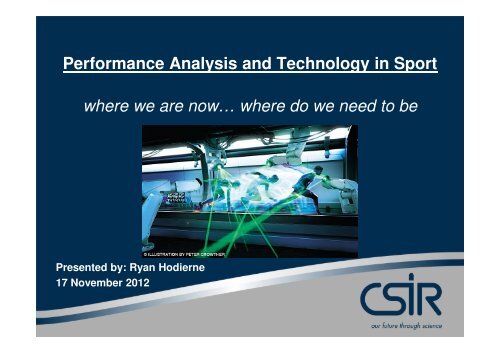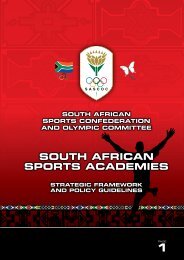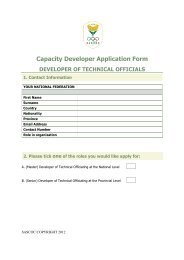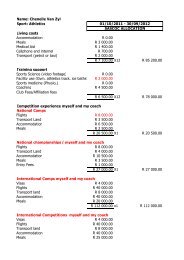Performance Analysis- Ryan Hodierne - HP
Performance Analysis- Ryan Hodierne - HP
Performance Analysis- Ryan Hodierne - HP
Create successful ePaper yourself
Turn your PDF publications into a flip-book with our unique Google optimized e-Paper software.
<strong>Performance</strong> <strong>Analysis</strong> and Technology in Sportwhere we are now… where do we need to bePresented by: <strong>Ryan</strong> <strong>Hodierne</strong>17 November 2012
<strong>Performance</strong> analysis• Limits the element of subjectivity• Simplifies the process of feedback• Minimizes the element of surprize in competition• Data is there to reinforce what the coach and the athletethinks• Allows to alter tactics to minimize the opponents strengthsand optimize their weaknesses“If you can measure something, you can improve it”
“Although in the past there was some resistance to the useof data in sport – and some sports are still reluctant towholeheartedly embrace and put faith in the power ofanalytics – over the last few years there has been a sea ofchange in attitude”Stafford Murray (head of performance analysis & biomechanics at the EIS)
2012 London Olympics – medal tally
2012 London Paralympics – medal tally
Team GB – Olympic Funding• UK Sport invested ± £550mil over the Beijing and London Olympiccycles• Olympic expenditure comparisons:- Beijing = £235,103,000 (± R 3,3mil)- London = £264,143,753 (± R 3,7mil)• Team GB spending per sport for London 2012• Rowing• Cycling- £ 27mil- £ 26 mil• (high cost due to expenditure on latest technology – bikes / helmets / clothing “hot pants”)• Athletics - £ 25 mil• Swimming - £ 25 mil
Team GB – cost per medal for 2012Graph compliments of The GuardianPosted by Koos CouvéeMonday 13 August 2012
Team GB – Olympic Funding• Boxing = most cost effective with 5 medals, 3 gold• Cycling and Rowing = best value for money• Cycling:- 12 medals, 7 gold in track discipline- Quoted as being the better team due to “technological superiority”- Each cycling medal = £2.2mil (R31mil)• Rowing:- 9 medals, 4 gold- Big on technological support- Each rowing medal = £3mil (R42mil)• Swimming:- 3 medals, 1 silver / 2 bronze- Each swimming medal = £8.4mil (R118mil)• Average cost per Team GB medal = £4.6mil (±R64mil)
Medal tally: hosting vs. non-hosting
Olympic funding• Hosting nations get an injection of financial support• However… money does not buy medals!• Though money does- Allow for high-tech testing- Prolonged research and development- Allow for trial and error- Time in a wind tunnel
Technological intervention in Sport• Within an Olympic cycle, four years is a long time whenconsidering the progression of technology.
Domains of TechnologyInformation and knowledgemanagementCommunications technologyNotational analysisVideo-based biomechanicalanalysisTelemetryDatabases to monitor and track athletes, as well as data miningtechnologies.Real time transfer of knowledge and information to athletes and teamswithin the framework of existing rules and regulations.Objective analysis, quantification and analysis of the critical incidents(tactical and strategic) in game performance that influence outcomes.Technique and performance analysis.Remote monitoring of athletic performance in real time.Simulation and modellingAs more data becomes available on players, such as their reaction times,sprint speed, body mass as well as attacking and defending patterns,such information can be used in modelling and simulating performance.Virtual realityVR simulators can be used to enhance the decision making skills in avast array of sports.© CSIR 2010 www.csir.co.za
CANOEING, TESTING IN SUBMARINE TANK: Jon Schofield and Liam Heath paddling up and down the 270m pool, with videocameras being used to monitor their speed and split times
AERODYNAMICS TESTING: Mercedes-AMG-Petronas wind tunnel @ £3,000 (R 42,000) per day
DIMPLED BODY SUITS: drawn inspiration from golf balls and designed to reduce aerodynamic drag; wind-tunnel tests have proventhat it can potentially reduce times by 0.023 second
Technological concerns• There is a fear of engineering overshadowing the triumphof human spirit and ability• A worry that the “best athletes” might not win• The thought of sports engineering giving richer countriesan advantage over poorer countries800m WR (wheelchair)• 1980’s = 1:55.67• Current WR = 1:32.17 (- 23.50sec!)
The controversy• “Technology doping”• Swim suits of Beijing 2008 – 25 world records inswimming alone• London 2012 - 25 world records set in total- 8 world records in swimming- Swimming times continue to get faster ( more focus on technique /better attention to detail)
In prevention of these concerns…• Olympic governing bodies need to pursue the following:- Actively monitor the latest technologies (ideally beforeimplementation)- Planning is required rather than just reacting- Rule books need to be re-written and reviewed over shorter timeframes- Closer ties need to be developed with engineering firms
ENGLISH INSTITUTE OF SPORT (EIS)• HQ in Manchester – sites around the country• Employs 30 full-time performance analysts• Each dedicated to a sporting code• 2012 London Olympics:- 17 EIS analysts- Provide visual & data feedback to respective coaches- Captured footage from 40 TV feeds (BOA)- Footage then fed to 23 individual sporting codes via- Dartfish TV web platform for analysis
ENGLISH INSTITUTE OF SPORT (EIS)• <strong>Performance</strong> Analysts: London vs Beijing• Olympics = 17 vs 5• Paralympics = 4 vs 1• The biggest challenge still…- delivering information faster and in a form that can most effectivelybe used by teams and individuals
EIS – research and developmentWhat they wanted:real-time wireless data tracking for swimming (during training)• British Swimming challenged 3 different Universities to developthe technology• 8cm x 5cm box fitting into the small of a swimmers back• collates data from pressure mats and sensors around the pool• data is transmitted to a laptop on poolside• data includes: push-off time from blocks airtime during dive total time in contact with wall during turns
The use of Simulcam in analysis• Allows to split screen views• Can analyse pre and post performances- Pre and post injury- Pre and post coach intervention• It allows to overlay before and after footage to highlight thedifferences
The use of Stromotion in analysis• Track paths of motion• Select key positions within complex movement patterns• Provides a great coaching tool
Mobile <strong>Analysis</strong> tools and applications
Current levels of intervention in SA Sport• Race performance analysis- Data feedback on performance variables- Identifying athlete strengths and weaknesses- Pin-pointing areas of improvement- Profiling competitors• Creation of athlete databases in performance tracking- Variables include performance / health / psychology• Telemetry in training variables of team / individual performances- used in team selection or identifying ideal combinations or techniques• Long term athlete development at academy level• Minor technological intervention at national / provincial training level
Key areas of focus in SA Sport• Coaches education- Familiarization with technologies- Tailoring data analysis to their requirements- Equip coaches / assistants with tools and knowledge for self-help• Technological support- Educate the necessary people (sports scientists / biomechanists)- Invest in necessary equipment- Implement where it will be of greatest impact- Filter the intervention through to other sporting codes• <strong>Performance</strong> analysis- Implement at club / provincial level- Feedback should be simple but effective- Data should reflect grounding and reliable information- Seek repeatability
Key areas of focus in SA Sport (continued)• Research and development- Must be on going in as many fields as possible- Should provide practical, real-life and useable data- Results should be applied where applicable• Human capital development- Create interest at tertiary level- Avenues of specialization should be made available- Certificate courses and or degrees should be attainable
Heading toward Rio 2016 and beyond…• Greater technological intervention at club and provincial level• More consistent scientific intervention during training andcompetition at national and international levels• Continued and collective nationwide, inter-provincial Talent ID
Heading toward Rio 2016 and beyond…(continued)• More regular sport / athlete database updates from more frequentevents• Consistent athlete performance tracking- at national and international level• Allocation of performance analysts to priority sporting codes- must be given other codes to advance with in coverage of all Olympiccodes- Team SA to London 2012 = 17 sporting codes- The bare minimum requirement of analysts for any sort of impact• 2 – 3 notational analysts (team sports)• 3 – 5 performance analysts (roaming)
In conclusion…• Technological support is really there for quality control• <strong>Performance</strong> analysis is an additional tool to the coach• <strong>Analysis</strong> will never replace the human aspect of performance• Technological support in performance analysis in professional sportcan no longer be an after thought!
Thank you for your attention<strong>Ryan</strong> <strong>Hodierne</strong>ryan.hodierne@newbalance.com










